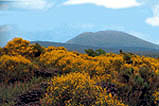

Mount Vesuvius is an active volcano, originated during the late Pleistocene Epoch. It is famous for its catastrophic eruption in 79 A.C. when the town of Pompei, Herculaneum, Oplonti and Stabiae were completely destroyed and buried in less than two days time. Pompei was buried under 10 feet (3 m) of tephra, while Herculaneum was buried under 75 feet (23 m) of ash deposited by a pyroclastic flow. More than 3300 people died during the eruption. During its history, Mount Vesuvius has alternated periods of intense eruptive activity to cycles of quiescence. Since the eruption of 79 A.C. it erupted violently twice: the first time in 472 A.C. and the second time in 1631 when almost 3500 people were killed.
During the last 3 centuries the activity of the volcano has been characterised by eruptions of medium scale but of spectacular effects which has made the Vesuvius one of the aims of travellers, scientists and artists from all over the world.
After the last eruption in 1944, the volcano has entered a cycle of quiescence and no one can predict how long it is going to last. In the last decades the area around the Vesuvius has been jolted by small earthquakes and its activity is proved by the presence of two major fumarole in the volcanic area.
The eruptive history of this volcano proves that the Vesuvius is still alive and is to be considered one of the most dangerous volcanoes.
The Vesuvian Observatory, inaugurated in
1845 by Ferdinando II, king of the Reign of Two Sicilies, is the
first seismic observatory to be establish in the world. For more
than 150 years it has assured a constant and detailed observation
of the vesuvianae eruptions and its precursors. Now the
observatory keeps under control the activities of the vulcanoes
present in Campania and it is capable of catching any signs of a
renewed activity. ![]()
If you are coming from a search engine please visit our home page otherwise return to top or to Herculaneum history
|
Up |